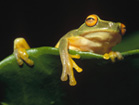The rediscovery of another species - a painted frog - in a city of Boyaca (Colombia), was announced some month ago. Some leading scientists say amphibians are on the front line of what may be the worst extinction crisis. Gascon said that it was not clear if the frogs had resisted the skin fungus - chytridiomycosis - or were in a region as yet unaffected.
New disease killed frogs on the range of near 25 miles from the site of the latest finds. Alarmed by extinctions, amphibian experts are seeking more than $400 million to fund captive breeding in zoos and aquariums -- already aiding about 35 species.
However, frogs cannot be re-introduced to the wild because of the disease. DOOMED TO FAIL "We can treat the disease in captivity but any re-introduction program is doomed to fail," said Joe Mendelson, a curator at Zoo Atlanta and the acting head of the amphibian specialist group at the World Conservation Union.
"Capture programs are usually all about supporting populations in the wild. Because of the disease this can't work," he said. He said captive breeding could be expanded to help "hundreds, if not thousands, of species." Amphibians - toads, frogs, newts and some worm - like creatures - are highly vulnerable to disease, pollution or changes in temperature because they live on both land and in water and have a porous skin that absorbs oxygen. Some vanished species might have had skills valuable to humans. "You can imagine the kind of knowledge in terms of helping fight ulcers that the gastric brooding frog might have held".
Gascon said the rediscovery of the frogs showed that preservation of small habitats - such as the El Dorado reserve where the two frogs were found in Colombia - could be a key to saving many threatened species. A global group of conservationists, the Alliance for Zero Extinction, said last year that preserving 595 sites around the world could help save 794 endangered species.
